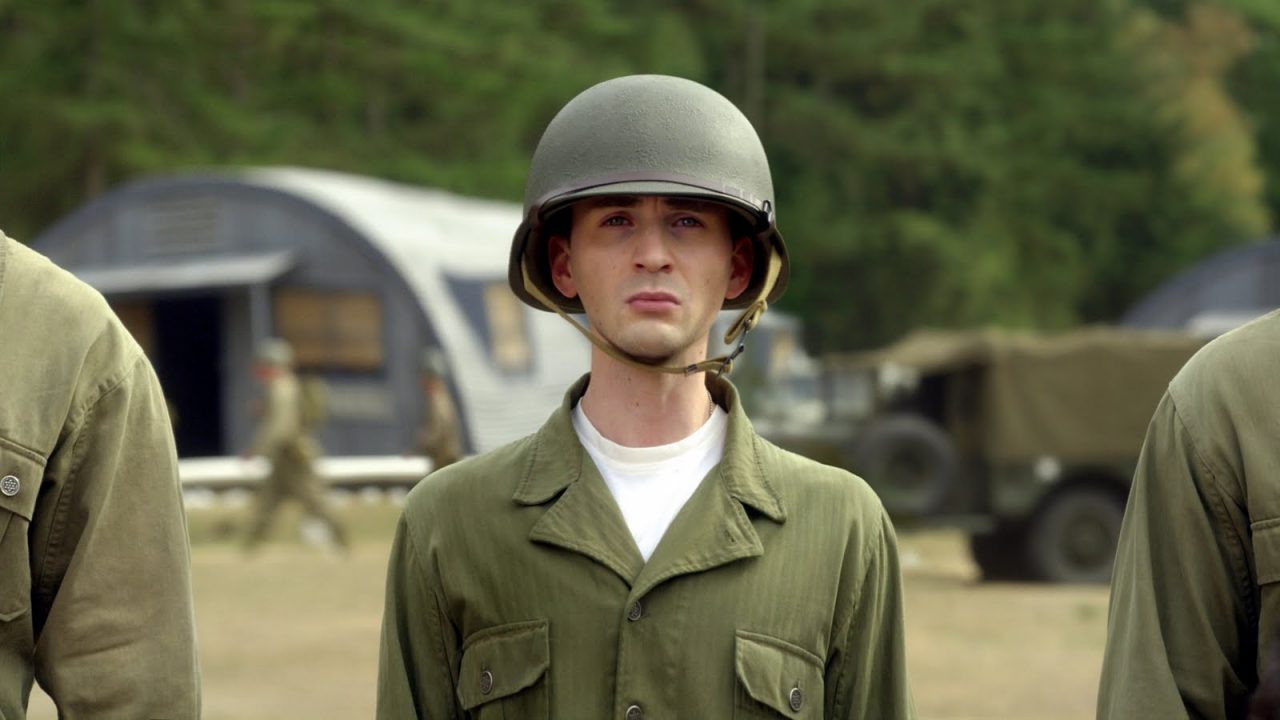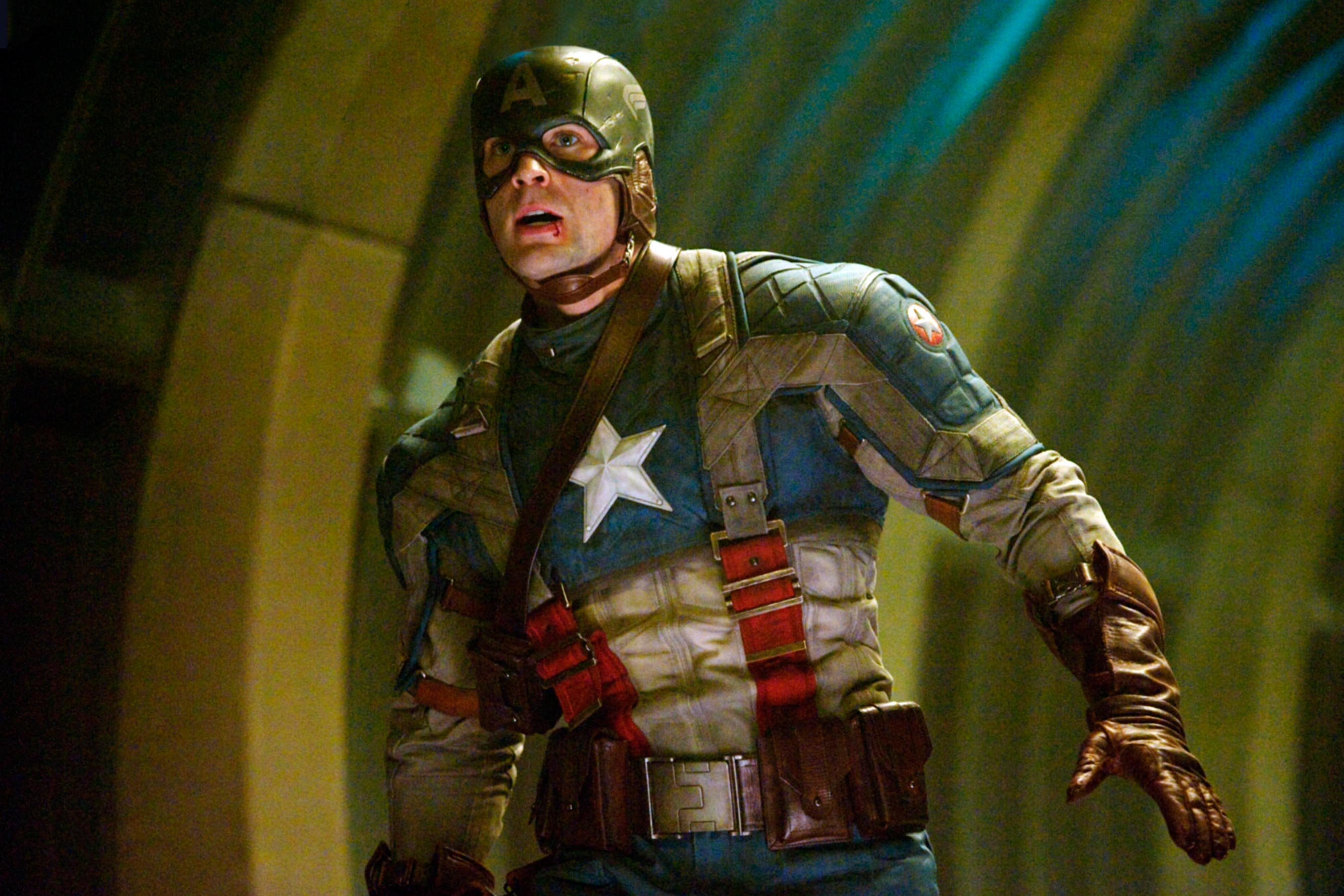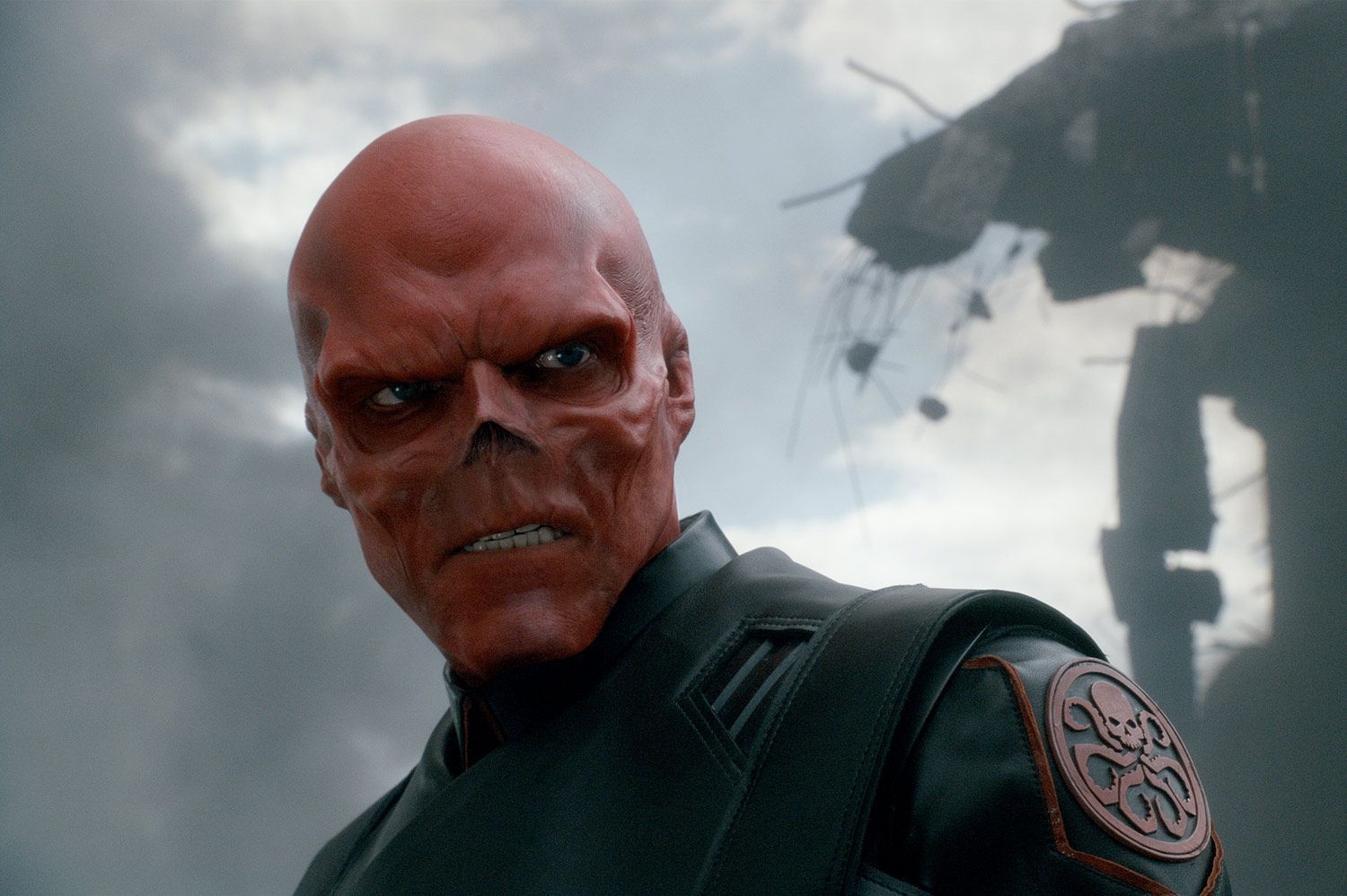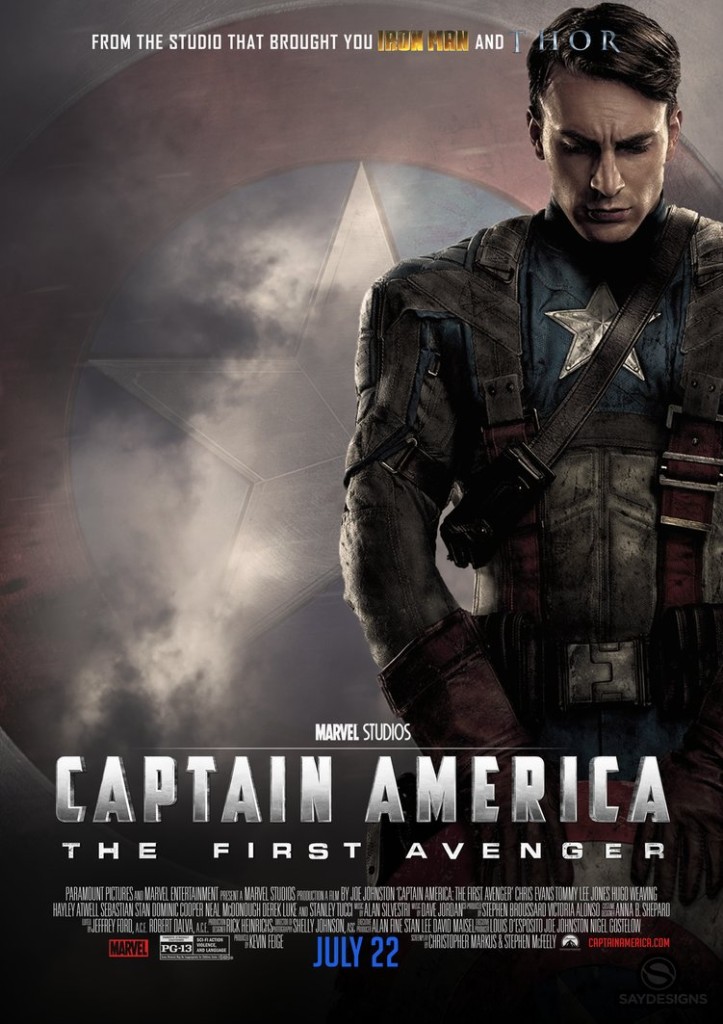USA. 2011.
Crew
Director – Joe Johnston, Screenplay – Christopher Markus & Stephen McFeely, Based on the Comic-Book Captain America Created by Jack Kirby & Joe Simon, Producer – Kevin Feige, Photography – Shelly Johnson, Music – Alan Silvestri, Visual Effects Supervisor – Christopher Townsend, Additional Visual Effects Supervisors – Stephane Ceretti & Kathy Siegel, Visual Effects – Double Negative, Framestore (Supervisor – Jonathan Fawkner), Fuel VFX (Supervisor – Dave Morley), Lola VFX (Supervisor – Edson Williams), Look Effects, Luma Pictures, The Senate Visual Effects (Supervisor – Richard Higham), Trixter (Supervisor – Alessandro Cioffi) & Whiskytree (Supervisor – Jonathan Harb), Special Effects Supervisor – Paul Corbould, Prosthetic Makeup Designer – David White, Production Design – Rick Heinrichs. Production Company – Marvel Studios/Paramount.
Cast
Chris Evans (Steve Rogers/Captain America), Hayley Atwell (Agent Peggy Carter), Hugo Weaving (Johan Schmidt/The Red Skull), Tommy Lee Jones (Colonel Chester Phillips), Dominic Cooper (Howard Stark), Toby Jones (Dr Armin Zola), Sebastian Shan (Sergeant James ‘Bucky’ Barnes), Stanley Tucci (Dr Abraham Erskine), Samuel L. Jackson (Nick Fury), Neal McDonough (Timothy ‘Dum Dum’ Dugan), Richard Armitage (Heinz Kruger), Michael Brandon (Senator Brandt), Kenneth Choi (Jim Morita), J.J. Feild (James Montgomery Falsworth), Derek Luke (Gabe Jones), Bruno Ricci (Jacques Dernier), Lex Shrapnel (Gilmore Hodge), David Bradley (Tower Keeper), Natalie Dormer (Private Lorraine)
Plot
In 1942, Steve Rogers is determined to enlist in the US army and serve in World War II but is rejected after multiple applications because of his puny physique and health problems. Dr Abraham Erskine overhears Steve talking with his best friend James ‘Bucky’ Barnes and rubberstamps him for acceptance into a special division of the Strategic Scientific Reserve. There Erskine selects Steve over the other recruits because of his heroic qualities and invites him to become part of a super-solider program. Steve is then injected with a serum that instantly gives him a huge, brawny physique. Immediately after, a spy from the Nazi Hydra organisation attempts to steal samples of the formula and shoots Erskine, before being stopped by Steve. With Erskine dead, the program is shut down. Steve is then recruited as a hero for the war bonds drive where he appears in a costume calling himself Captain America. While touring the front, Steve learns that Bucky’s unit has been captured. Steve goes out on his own and conducts a single-handed rescue of the unit from a Hydra base. In doing so, he comes up against Hydra head, scientist Johan Schmidt, who is nicknamed the Red Skull because his face has taken on a scarlet-skinned skull-like appearance due to exposure to an alien energy cube known as The Tesseract. Now proclaimed a hero, Steve is provided with a patriotic costume, a gadget-outfitted motorcycle and a shield made of vibranium to head an elite team of soldiers to go into action and prevent the Red Skull’s plans for world conquest.
Captain America is one of the key superheroes in the Marvel Comics pantheon – indeed, is one of the oldest superheroes still around today. First appearing in Captain America Comics #1 in March 1941, as created by Joe Simon and the cult figure of Jack Kirby, Captain America was intended as a patriotic superhero. (Captain America interestingly prefigured the US’s entry into World War II – Simon and Kirby were trying to express their abhorrence at Germany’s actions in Europe and the first two issues featured covers with Captain America tackling and punching out Adolf Hitler). Captain America enjoyed great popularity with Wartime audiences, appearing in several titles, but Captain America Comics ended in 1950 after 75 issues with patriotism on the wane following the War. Marvel revived Captain America in 1964 in The Avengers #4, introducing an important retcon that has become a facet of every incarnation since where Steve Rogers was frozen after crashing in the polar wastes and revived several decades later. Since then, Captain America has gone onto enjoy a great deal of success in a series of adventures in the present-day, while also acting as leader of The Avengers. The character was killed off in the famous story arc The Death of Captain America (2007-8), although, as is wont with comic-books, this has recently been overturned.
Captain America has been incarnated on the screen a number of times. Around the publication of the original Wartime comics, the character was adapted into a 15 chapter serial Captain America (1944) starring Dick Purcell. Captain America also appeared as part of the animated series The Marvel Super Heroes (1966), which featured a different Marvel superhero every day of the week. The character was then revived in two shabby tv movies, Captain America (1979) and Captain America II (1979) starring Reb Brown, unsold pilots that were part of a package of Marvel properties adapted to tv in the late 1970s. These have Steve Rogers becoming Captain America in the present-day with no mention being made of him as a Wartime hero. Next up was Albert Pyun’s cheap and laughable Captain America (1990) starring Matt Salinger, which at least adhered to the basics of the comic-book and had him revived in the present-day to continue battling The Red Skull. The Captain America origin story is also told in the animated Ultimate Avengers (2006) and he has appeared in other Marvel animated films such as Ultimate Avengers II (2006) and Next Avengers: Heroes of Tomorrow (2008).
With Captain America: The First Avenger, Captain America joins a host of Marvel Comics superheroes that have become a major industry on cinema screens in the 00s, alongside the likes of Blade (1998), X-Men (2000), Spider-Man (2002), Daredevil (2003), Hulk (2003), The Punisher (2004), Elektra (2005), Fantastic Four (2005), Man-Thing (2005), Ghost Rider (2007), Iron Man (2008), Thor (2011), Guardians of the Galaxy (2014), Ant-Man (2015), Deadpool (2016), Doctor Strange (2016), Black Panther (2018), Venom (2018), Captain Marvel (2019), Black Widow (2021), Eternals (2021), Shang-Chi and the Legend of the Ten Rings (2021), The Fantastic 4: First Steps (2025) and Thunderbolts* (2025) and various sequels to almost all of the above, as well as the tv series’ Agents of S.H.I.E.L.D. (2013-20), Daredevil (2015-8), Agent Carter (2015-6), Jessica Jones (2015-9), Luke Cage (2016-8), The Defenders (2017), Inhumans (2017), Iron Fist (2017-8), The Punisher (2017-9), Runaways (2017-9), The Falcon and the Winter Soldier (2021), Hawkeye (2021), Loki (2021- ), WandaVision (2021), Moon Knight (2022), Ms Marvel (2022), She-Hulk: Attorney at Law (2022) and Secret Invasion (2023).

These became part of an extraordinarily ambitious plan to unite the Marvel characters together in the same universe, as witness the subtitle The First Avenger here where much of the film is set up for the Marvel team-up The Avengers (2012). All of the Marvel films since Iron Man have taken to sharing characters and dropping in-references to the rest of the universe – Captain America’s shield was seen in the background of both Iron Man and Iron Man 2 (2010), for instance, while The Tessarect was introduced in the post-credits sequence at the end of Thor. Here the by now de rigeur post-credits Easter Egg features Samuel L. Jackson’s Nick Fury recruiting Steve Rogers for The Avengers and is followed by a teaser clip for The Avengers film.
Having sat through my fourth major A-budget comic-book adapted superhero film in as many months, beginning with Thor back in May, followed by X: First Class (2011) and DC’s Green Lantern (2011), I feel like I am starting to reach superhero ennui by the time I sit down to watch Captain America: The First Avenger. While I am not entirely sure if that is the problem here, I did find Captain America a major letdown. I have defended other less than popular Marvel works such as Ang Lee’s Hulk, Blade Trinity (2004) and Fantastic Four, even found merits in the generally disliked Elektra, Ghost Rider and X-Men Origins: Wolverine (2009), but Captain America: The First Avenger emerges as one of the flattest Marvel Comics adaptations to date.
The director of Captain America: The First Avenger is Joe Johnston, a former Industrial Light and Magic art director who had worked on the original Star Wars trilogy before making his directorial debut with Honey, I Shrunk the Kids (1989). Since then, Joe Johnston has maintained a steady hand with effects-driven, frequently genre projects such as Rocketeer (1991), The Pagemaster (1994), Jumanji (1995), October Sky (1999), Jurassic Park III (2001), Hidalgo (2004), The Wolfman (2010), Not Safe for Work (2014) and The Nutcracker and the Four Realms (2018). You sense that one of the reasons that Joe Johnston was selected for directing Captain America: The First Avenger was because of Rocketeer. Though it was not a box-office success, Rocketeer was a similar comic-book superhero film set in a retro 1930s/40s era – indeed, both Rocketeer and Captain America feature very similar industrialist entrepreneurs who aid the hero with technological innovations (in Rocketeer, it was the real-life figure of Howard Hughes, which the character of Howard Stark here appears to have been based on more than a little).
The script for Captain America: The First Avenger comes from the writing duo of Christopher Markus and Stephen McFeely who also wrote all three of Walden Media’s Chronicles of Narnia films. Markus and McFeely are faithful to the comic-book originals – with appearances from characters such as Dr Abraham Erskine, General Chester Phillips, Armin Zola (albeit minus his headless artificial body), the second incarnation of the Red Skull Johan Schmidt and namedrops of vita-rays, vibranium, the Hydra organisation and The Tesseract/The Cosmic Cube. The script also winds up a squad taken from members of various of Marvel war hero teams such as the Freedom Five and Sergeant Fury’s Howling Commandos. There are some changes to the comic-book original – in the look of the Captain America costume and with the character of Bucky bumped up in age from his teens where he was originally the camp mascot who became Captain America’s sidekick to now become Steve Rogers’ best friend. Markus and McFeely’s script is commendable for its effort to treat Captain America seriously – giving us convincing reasons for Rogers’ selection into the super-soldier program, the adoption of the name Captain America, the costume and shield.

Captain America: The First Avenger has had a more than reasonable budget thrown at it, with lavish production values and an army of visual effects companies behind the scenes, not to mention a fine cast line-up (Tommy Lee Jones, Hugo Weaving, Toby Jones, Stanley Tucci, even Chris Evans who has emerged as promisingly handsome and assured in the various films he has appeared in to date) and a script that determines to treat the character seriously. Despite all of this, the film promptly dies in Joe Johnston’s hands. I am not entirely sure what went wrong here as Joe Johnston has made a good showing in his other effects vehicles and did the period adventure well before in Rocketeer. However, Johnston’s handling here is painfully old-fashioned – four-square shots with plodding scene transitions and everything presented in a dim faded tone that makes it look like a bad digital projection (even dimmer if you are being bilked to watch the film in post-converted 3D). Most of the period sets come off as being something that have only been created for the camera’s eye and fail to feel lived in.
The first half of the film is a series of drawn-out scenes where Steve Rogers is recruited, undergoes training and is then chosen for the super-soldier program. This takes up about three-quarters of an hour of running time. You then think “great, finally we get to see Captain America in action – maybe the film will pick up” but even after Rogers is transformed, the film spends another twenty or so minutes on far too many scenes of him performing as a USO poster boy. Finally, more than two-thirds of the way into the film, Joe Johnston gets Captain America into action. There are then some okay scenes with him leading assaults on various Hydra bases, demolishing hordes of soldiers with fists and shield, and a reasonable climactic mid-air battle aboard the Red Skull’s Flying Wing. However, there are rarely many times that the film gains the kind of exhilarating life where it soars as something like X-Men and Iron Man, the Spider-Man films, even the Blade films did.
The other great surprise is that, apart from a brief wraparound at the start and slightly more than five minutes of scenes at the end, all of Captain America: The First Avenger takes place during the World War II era. The 1960s retcon of bringing Captain America into the present-day has become so prevalent that it is a surprise when the film returns to what is after all the original Captain America. By contrast to what we have here, the Albert Pyun Captain America got the creation and resurrection of Captain America over with in its first half-hour; Ultimate Avengers did it in less than ten minutes; the 1979 version kept Steve Rogers strictly in the present and eliminated any mention of World War II. This also creates some storytelling problems. When the climactic scenes consist of a bewildered Steve Rogers emerging from S.H.I.E.L.D. headquarters into Times Square and being told by Nick Fury that he has been frozen for seventy years, it ends the film on something abruptly unsatisfying – it feels more as though one has reached the end of Part 1 of a two-part story. These are problems created by trying to fit everything into the new Marvel Cinematic Universe with the clear expectation that this is going to be continued in The Avengers. However, watching Captain America: The First Avenger as self-contained entity, it proves extremely unsatisfying.

Maybe the film’s biggest disappointment is its portrayal of The Red Skull. The script skips over giving The Red Skull almost any development at all – little or nothing is explained about his background, how he gained the red skull appearance, even what his world domination scheme consists of, or for that matter what The Tesseract is meant to do (it is just a generic artifact of immense power and nothing more explained about it than that). The film fails to even give Captain America and Red Skull a decent showdown – merely has Red Skull accidentally eliminate himself after picking The Tesseract up. The biggest problem I had with the film’s Red Skull was the utterly anonymous makeup job applied to Hugo Weaving – every time he turned up on screen, I kept thinking he looked like one of those cartoon characters who has gotten so mad that their face turns red and smoke puffs come out of their ears. It may say something about how disappointing this film is when Albert Pyun’s cheap Captain America managed to provide a more menacing looking Red Skull.
Captain America: The First Avenger is no less than Chris Evans’s fifth comic-book film adapted film, he having appeared as Johnny Storm/The Human Torch in the two Fantastic Four films, voiced Casey in TMNT (2007) and appeared as a spoof superhero in Scott Pilgrim vs. the World (2010), as well as played a super-powered character in the non-comic-book adapted Push (2009). I have enjoyed Evans’ cocky smoothness through most of these roles. On the other hand, he seems an ill fit as Captain America. The first third of the film has him digitally reduced to playing a proverbial 98-pound weakling where Evans plays appropriately wimpy. On the other hand, when he gets the super-soldier serum with pumped up abs and instant six-pack, he looks more like a plastic G.I. Joe/Action Man doll than he does a real person. Chris Evans plays the role earnestly straightforward and it seems the very act of doing so robs of it of anything interesting – even the larger-than-life heroic stature that you think Captain America should embody seems missing.
The film also does little with the rest of its name cast. Despite casting estimable names such as Hugo Weaving and Toby Jones in parts, they are left doing little more than enacting B-movie Nazi villainy and German accents – Jones emerging with slightly more depth in this regard than Weaving. Haley Atwell plays a one-dimensional role that is defined by no more than a British accent, red lipstick and deft right hook. Tommy Lee Jones at least peppers up his role with customary crusty sarcasm. Stanley Tucci emotes seriously and tries to give his all to make a one-dimensional role seem more than that but is fighting a vain battle.
Chris Evans returned in the sequels Captain America: The Winter Soldier (2014) and Captain America: Civil War (2016). Evans’s Captain America also appeared as one of the members in the Marvel team-ups The Avengers, Avengers: Age of Ultron (2015), Avengers: Infinity War (2018) and Avengers: Endgame (2019), while Evans also made a cameo as one of the disguises adopted by Loki in Thor: The Dark World (2013). This was followed by Captain America: Brave New World (2025) with Anthony Mackie inheriting the role of Captain America. Hayley Atwell’s Agent Carter was later spun out in the tv series Agent Carter (2015-6), which connected up with other aspects of the Marvel Universe immediately following World War II.
(Nominee for Best Production Design at this site’s Best of 2011 Awards).
Trailer here


